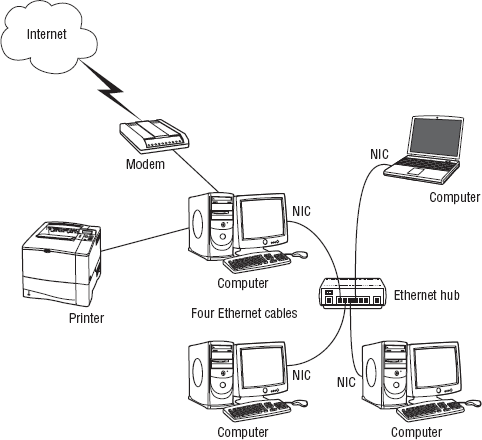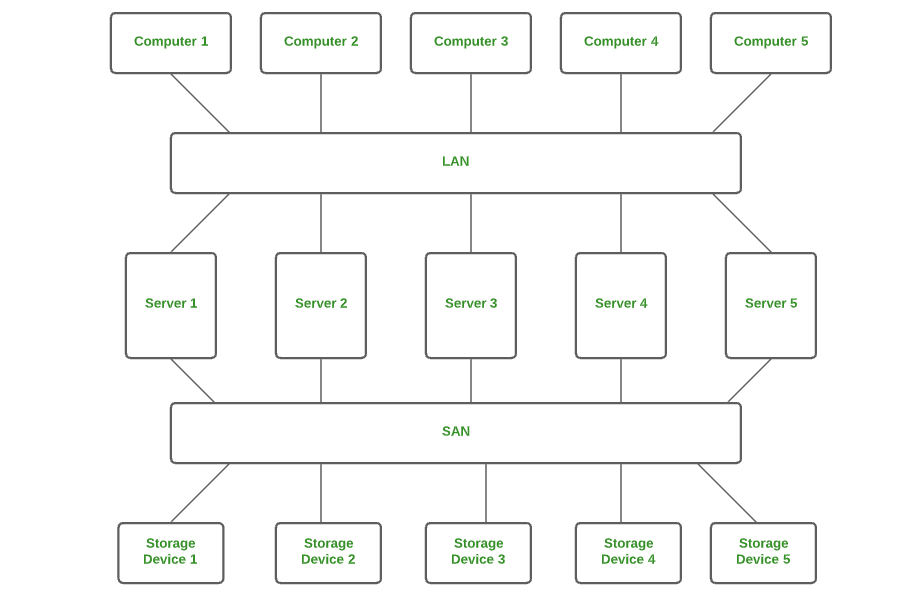Types of Networks: A Comprehensive Overview
Types of Networks: A Comprehensive Overview
INTRODUCTION
In the modern era of advanced technology, networks play a pivotal role in connecting devices, facilitating communication, and enabling the exchange of information. A network is a collection of interconnected devices, such as computers, servers, routers, and switches, that work together to share resources and data. Networks can be classified into various types based on their size, geographical distribution, and purpose. In this comprehensive overview, we will explore different types of networks, including local area networks (LANs), wide area networks (WANs), metropolitan area networks (MANs), virtual private networks (VPNs), wireless networks, and more.
I. Local Area Networks (LANs)
A Local Area Network (LAN) is a network that spans a small geographical area, typically within a single building or campus. LANs are used to connect devices in close proximity, such as computers, printers, and servers. They provide high-speed data transmission and are commonly implemented in homes, offices, schools, and small businesses. LANs can be further categorized into wired LANs and wireless LANs.
I. Wired LANs
- Ethernet LAN: The most common type of wired LAN, Ethernet networks use twisted pair or fiber optic cables to connect devices. They follow the Ethernet standard and provide reliable and high-speed data transmission.
- Token Ring LAN: Token Ring networks use a ring topology, where devices pass a token to gain access to the network. This method ensures fair sharing of network resources.
II. Wireless LANs
- Wi-Fi: Wireless Fidelity (Wi-Fi) networks use radio waves to transmit data between devices. They provide the convenience of mobility and are widely used in homes, offices, and public spaces.
- Bluetooth: Bluetooth technology enables short-range wireless communication between devices, commonly used for connecting peripherals like keyboards, mice, and headphones.
2. Wide Area Networks (WANs)
Wide Area Networks (WANs) span large geographical areas, connecting devices across cities, countries, or even continents. WANs utilize telecommunication links, such as leased lines, satellite links, or public networks, to establish connectivity. They allow organizations to connect their remote offices, branch locations, and data centers. Some common types of WANs include:
IV. Point-to-Point Links
- Leased Lines: Leased lines are dedicated connections between two locations, providing a secure and reliable connection. They offer high bandwidth and are commonly used for data-intensive applications.
V. Packet-Switched Networks
- X.25: X.25 networks use packet-switching technology to transmit data over long distances. They were widely used before the emergence of the Internet and provided reliable but relatively slow connections.
- Frame Relay: Frame Relay networks provide faster data transmission compared to X.25. They use virtual circuits to establish connections between devices.
- Asynchronous Transfer Mode (ATM): ATM networks transmit data in fixed-size packets called cells. They offer high bandwidth and low latency, suitable for multimedia applications.
3. Circuit-Switched Networks
- Integrated Services Digital Network (ISDN): ISDN networks use digital circuits to transmit voice, data, and video signals. They provide a dedicated connection and are widely used for telephone and video conferencing.
VI. Metropolitan Area Networks (MANs)
Metropolitan Area Networks (MANs) cover larger areas than LANs but smaller areas than WANs. They connect multiple LANs within a city or metropolitan area, enabling data sharing and resource access. MANs are often owned and operated by service providers or government organizations. Some examples of MAN technologies are:
1. Fiber Distributed Data Interface (FDDI): FDDI networks use fiber optic cables to provide high-speed data transmission within a metropolitan area. They offer fault tolerance
and are suitable for mission-critical applications.
2. Switched Multi-megabit Data Service (SMDS): SMDS networks use packet-switching technology to transmit data across a metropolitan area. They provide high bandwidth and low latency.
VII. Virtual Private Networks (VPNs)
Virtual Private Networks (VPNs) establish secure connections over public networks, such as the Internet, by encrypting data traffic. VPNs enable remote users to securely access resources within a private network. They are widely used to enhance security and privacy. Some common types of VPNs include:
1. Site-to-Site VPNs: Site-to-Site VPNs connect multiple sites or branch offices of an organization securely over the Internet. They allow seamless communication and data sharing between different locations.
2. Remote Access VPNs: Remote Access VPNs enable individual users to connect to a private network from remote locations. This is commonly used by employees who need to access company resources while working from home or traveling.
VIII. Wireless Networks
Wireless networks utilize wireless communication technologies, such as radio waves, to transmit data between devices without the need for physical cables. They provide flexibility and mobility. Some notable wireless network types include:
1. Wireless Personal Area Network (WPAN): WPANs are short-range wireless networks used for connecting personal devices. Bluetooth is a common example of a WPAN technology.
2. Wireless Local Area Network (WLAN): WLANs use Wi-Fi technology to establish wireless connections within a limited area, such as a home or office.
3. Wireless Metropolitan Area Network (WMAN): WMANs cover larger areas than WLANs, providing wireless connectivity within a city or metropolitan area. WiMAX is an example of a WMAN technology.
IX. Other Network Types
1. Storage Area Networks (SANs): SANs are dedicated networks used for connecting storage devices, such as disk arrays and tape libraries, to servers. They provide high-speed and centralized storage management.
2. Content Delivery Networks (CDNs): CDNs are geographically distributed networks of servers that cache and deliver content to users. They optimize content delivery and enhance user experience.
3. Peer-to-Peer Networks (P2P): P2P networks enable devices to directly communicate and share resources without a central server. They are commonly used for file sharing and decentralized applications.
Conclusion
In conclusion, networks are diverse and cater to various needs and environments. Local Area Networks (LANs) connect devices within a small area, while Wide Area Networks (WANs) span larger distances. Metropolitan Area Networks (MANs) cover metropolitan areas, and Virtual Private Networks (VPNs) provide secure connectivity over public networks. Wireless networks enable wireless communication, while other specialized networks like SANs, CDNs, and P2P networks serve specific purposes. Understanding the different types of networks is essential for building efficient and secure communication infrastructures in the digital age.












Comments